Fake Rhino Horn - Will fake trade pose a danger to regulated trade?
Counterfeit Rhino horn trade is big business within Africa and Asia of which poses a significant threat to any proposed legal Rhinoceros horn trade, regardless of what the pro trade lobby has suggested within online forums and meetings with governmental environmental agencies.
Within this article we look at just how big such trade is and whether it will actually threaten the proposed lifting of the still banned Rhino horn trade within South Africa.
Pro trade lobbyists believe that by flooding the market with genuine Rhino horn that such counterfeit trade will be diminished and should not pose any real significant threat to legal trade or increase poaching furthermore. Although the counterfeit trade is not really a major issue to any such proposed legal trade, criminals that want to make a quick buck regardless of any such trade being made legal will still continue peddling fake horn regardless of who the legitimate suppliers are. We are after all talking of “money making” here.
Rhino horn smugglers are now making very high quality fake horns, allowing unscrupulous hunters to sell the real horns at a huge mark-up to black market dealers for traditional medicine and status symbols.
The fake horns are made with top quality resins and look so authentic that they are almost impossible to distinguish from the real thing, a report presented July 2012 to members of the Convention on International Trade in Endangered Species (Cites) says. The report, presented to the convention’s standing committee in Geneva, says Cites officials have been alerted to the increasing involvement of “professional hunters in the illegal Rhino horn trade”. Yet hunters deny having any involvement within the trade whatsoever.
“Trophies are exported to hunters after a legal hunt, but once the hunters have received the trophies in their home countries, the original Rhino horns are removed from the trophies and replaced with fake horns.” This is rather interesting as since 2014, March our investigative unit the CICU has yet again viewed a staggering increase in what looks like real horns and fake horns online for sale.
Cites did not specify in which country the fake horns were being made and sold, but details in the report point to the possible involvement of either American or European hunters in the fake horn scam. In 2012, wildlife investigators in the US arrested several American and Vietnamese nationals in a major bust in several cities across the US following the seizure of numerous Rhino horns, some of which were suspected to have originated from legal Rhino hunts in SA and other parts of the continent.
There have also been a series of robberies from museums and private collections across Europe over the past two years in which the horns were stolen from mounted rhino head trophies.
“The fake horns were initially made with a mould and were relatively easy to identify, but recent reports from authorities indicate that fake horns encountered lately are made in high-quality resin with a density even higher than that of a real horn. “This makes visual identification, once fully mounted, extremely difficult.”
But Cites officials have now found a way to smoke out the culprits. “Fake horns can, however, be identified relatively easily by collecting and burning a small quantity of dust from the horn, which will deliver a distinctive smell indicating that it is not Rhinoceros horn.
“In the light of this new trend, it is of extreme importance that Cites parties should have adequate legislation and enforcement controls in place, to prevent horns that are part of legal exported trophies from being used for purposes other than hunting trophies, and to ensure that the trophies remain in possession of their owners.”
Another possible source of the fake horns could be in Vietnam, which has been implicated as the end destination of dozens of SA rhinos shot legally by Vietnamese poachers posing as bona fide trophy hunters. The report notes that Vietnamese authorities had pledged to conduct a stock-taking exercise to check whether SA Rhino trophy horns were still in the possession of Vietnamese hunters.
“It is vital for the authorities in Vietnam to conclude this activity as a matter of urgency and to investigate fully all incidents where trophies are no longer in possession of the hunters. Such follow-up investigations can provide important information on the identity of the driving force behind the trafficking of Rhino horn.”
People who no longer had their horn trophies should be able to tell investigators who the horns had be sold to.
While fake Rhino horn is fraudulent, there are numerous effective, viable and affordable substitutes for Rhino horn in traditional medicine, the use of which has been encouraged by government and traditional medicine authorities, and surveys indicate that most practitioners are adopting them. Consumer attitudes toward rhino horn as a medicine have been little studied (although research is underway in Viet Nam). In Japan, only 17% of nearly 1,200 people surveyed had heard of Rhino horn as a medicine, and just 1% said they had ever taken any.
Trade in counterfeit Rhino horn is not just problematic within Africa, Europe and Vietnam. Indian kingpins and traders have also devised ways in which to produce rather crude fake horn that has fooled buyers into purchasing leaving them out of pocket.
The standard advice to smell a Rhino horn to know if it is real or not has made con artists come up with fake substitutes made of wood and dry bamboo root with a little frog meat rubbed in for the authentic “odour”. In the clandestine world of Rhino horn smuggling, buyers are always in a hurry and usually go by the smell. And horn traders are making the most of it.
The “markets” are now flooded with these wooden horns and few can tell the real from the fake. A source in the forest department revealed the recipe: wood, dry bamboo root modified by using lac. “Meat of frogs and other animals is also rubbed on the fake horn to replicate the smell of a Rhino horn,” the source said.
The Rhino horn — which is in heavy demand in south Asian and middle-east countries — is prized for its supposedly aphrodisiac and unproven medicinal qualities. This alternative market came to light with the recovery of a fake rhino horn from Bokakhat town near Kaziranga National Park January 28th 2012. Two persons, Mrigangshu Kalita and Ajit Bora, were also apprehended from Bokakhat when they were about to strike a deal. Kalita, however, managed to give police the slip and escaped under cover of darkness. Bora hails from Garmurh in Bokakhat, while Kalita hails from Jorhat district and had been staying in a rented house in Bokakhat.
Acting on specific information, a team of forest officials set up a decoy and the duo were apprehended while they were waiting to meet a buyer. “We did not realise that the horn recovered from them was a fake one until we brought it to the forest range office and examined it,” a forest official said. “We are interrogating Ajit, more things will come to light,” he said.
Forest department sources said there has been a spurt in demand for Rhino horns in the international market recently. Assam has witnessed the death of 15 rhinos this year (2014). The last poaching incident took place last week of which two poachers were shot dead in a heavy battle.
The Telegraph had recently reported about a group of buyers from Bhutan camping at Mangoldoi town near Orang to buy the horn of a Rhino which was killed at the park on January 10 2012. A forest official, however, said the only positive side to the development is that buyers would now think twice before buying a Rhino horn from Assam.
Trading online;
International Animal Rescue Foundation’s CICU investigative teams located many peddlers online selling what is “believed” to be genuine horn and what appears to be wood crafted horn. The Convention on International Trade in Endangered Species of Wild Flora and Fauna seem non-to concerned that this trade “illegal” is quite clearly evident. What is more worrying though is that such a trade in counterfeit horn can have a serious detrimental effect on the proposed legalisation of real horn trade. Should fake trade hamper any legitimate trade then poaching will only increase if not rage completely out control leading to the extinction of our Rhinoceros within a matter of eight years if that.
Conservation Investigations Crime Unit located the following online - these traders are still actively selling wildlife parts ranging from Rhino horn, Elephant ivory, Tiger parts, Pangolins, Bear bile and skins from various mammals.
Mr Sidi Salem, Kafr El-Sheikh is selling below what appears to be crafted wooden Rhino horn for some £30,000 weighing in at an approximate 55 grams from the trading site dubizzle.com that is located wihtin Egypt. CICU department that runs Operation Trojan Horse has previously linked this area far north of Africa to rather large trade of ivory products. Late last year our investigative team located various “carvers” of which they are passed on various sums of ivory to be carved then smuggled into Saudi Arabia. From Saudi Arabia the parts are then smuggled into Eastern China.

A further trader is peddling what appears to be old (antique) Rhino horn from the classified site of be3weshtry.com one of many sites located within Egypt. The trader is a Yemeni man that is still trading from this site although there are no updated details. We cannot confirm if this is real or what may be counterfeit horn. Either way this trade is illegal and threatens any legitimate trade.
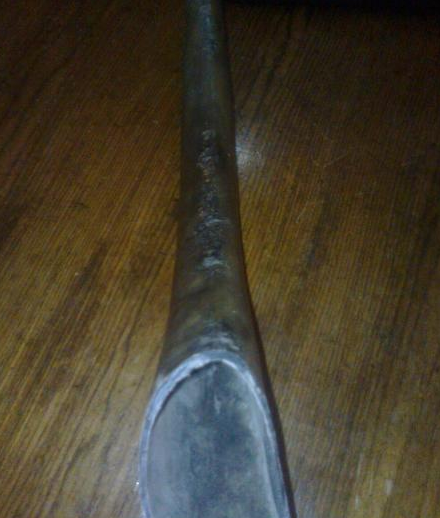
A third trader is peddling from another Egyptian site what he claims to be antique Rhino horn. On viewing such horn in great detail it appears more resin like rather than any real Rhino of which is clearly advertised. The site listed hereto is mmlkat-ala7jar.com has been under close observation by the CICU unit and EAD since 2012 of which is filled with many wildlife parts under the guise of “antique”.
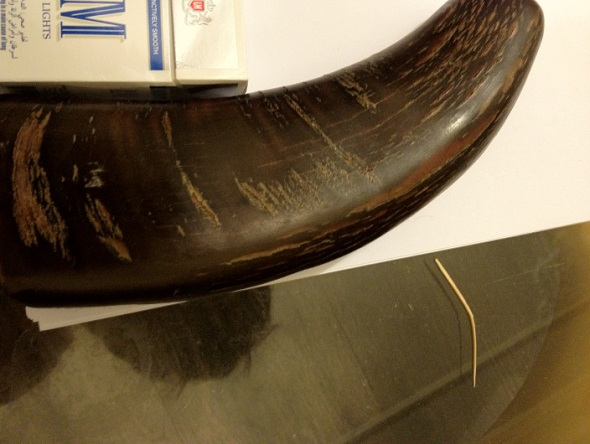
International Animal Rescue Foundation Africa printed recently on a rather suspect Rhino horn that was up for sale below. The horn, quite clearly is not antique as has been suggested within the article. The trader is still peddling even though Interpol Environmental Crimes Unit have been informed. Furthermore what is more concerning whom is supplying this individual from Africa with Rhino horn? This particular article is somewhat outdated however the CICU and EAD montier sites regularly of which they have passed on intelligence of conversation and potential sales of wildlife trade to the Interpol’s Environmental Crime Unit.
The trader that goes by the name of Razzer Q uploaded this one particular horn back in 2008. Intelligence has shown that this trader is also peddling in counterfeit horn and still trading from this site.
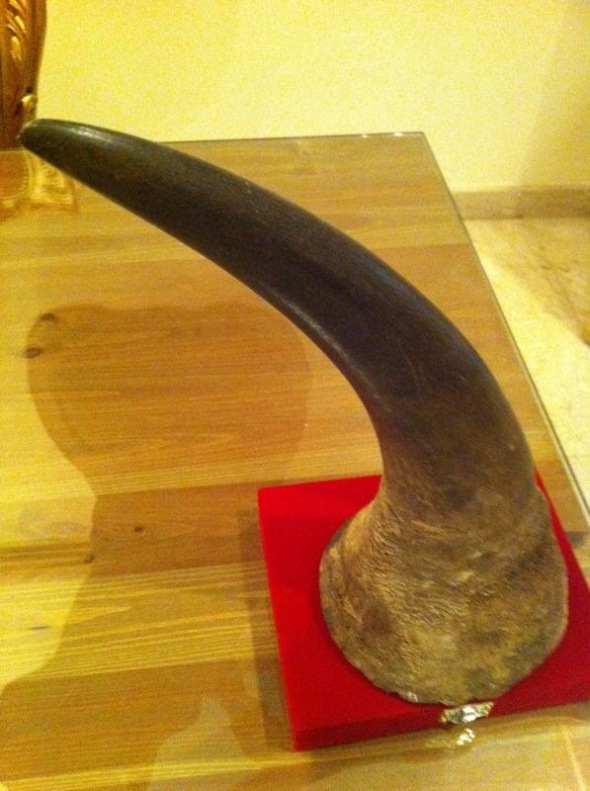
A fifth trader that quite clearly goes to the lengths of advertising all contact details, email, and cell number has been peddling again what appears to be “fake” Rhino horn from Egypt. We cannot state if this is real or counterfeit however evidence of such fake and real Rhino horn trade within northern Africa is growing by the month. Please click on the picture below for more information.
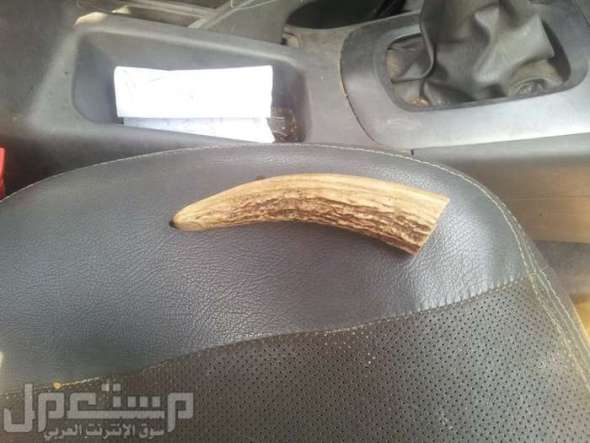
Just to give you an insight into how crude traders and scammers are online and on the ground, the picture listed below is from a trader advertising within the Ukraine what they state is their “own Rhino horn”. If one researches you’ll actually view what these scammers are selling are horns that were confiscated by wildlife and environmental investigative authorities. The scammer[s] have simply uploaded the pictures then created a site of which they are trying to fool potential buyers into believing they are actually purchasing illegally from legitimate traders. Click the picture for more information below.
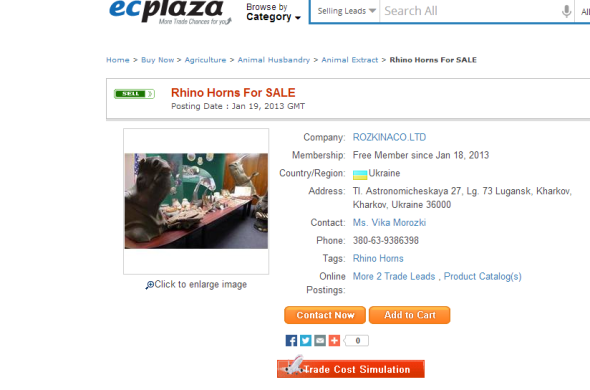 Fake Rhino horn trade is vast and spans the entire globe. Scammers also pose a significant risk to any potential legalised trade just as much as those that are peddling resin made Rhino horn. Conservation Investigations Crime Unit located a staggering 385 advertisements alone just within South Africa trying to scam purchasers with fake advertisements. Photography within these advertisements we can easily trace to pictures of seized Rhino horn.
Fake Rhino horn trade is vast and spans the entire globe. Scammers also pose a significant risk to any potential legalised trade just as much as those that are peddling resin made Rhino horn. Conservation Investigations Crime Unit located a staggering 385 advertisements alone just within South Africa trying to scam purchasers with fake advertisements. Photography within these advertisements we can easily trace to pictures of seized Rhino horn.
A RECENT study in Vietnam, sponsored by the World Wildlife Fund (WWF), reveals that demand for Rhino horn may be much larger than previously thought. It shows that, in addition to consumers of Rhino horn, there is a large group of “intenders” — people who intend to buy Rhino horn when they can afford it. The study shows that Rhino horn is bought not just for traditional medical purposes, but also as a status symbol. Rapid growth in living standards means the number of people who could become consumers of rhino horn is potentially enormous.
These findings cast doubt on the viability of proposals, supported by the South African government, to introduce a legalised, regulated market in Rhino horn. Supporters of such an approach believe a regulated market offers a better chance for the survival of the world’s remaining Rhinos than a ban on all trade. They argue that a ban on trade has perverse consequences — it raises the price of horn and so increases the incentive for poachers. By contrast, this view suggests that legal sales of stockpiled Rhino horns, plus the dehorning of live Rhinos to sell their horns, would drive down prices, reducing the incentive to poach. This is of course not proven and as much as one tries to argue this point with the pro trade lobbyists their main response is more in the line “we have to give it a try at least”.
Concluding we have many avenues that have still yet to be exhausted by the South African Government that may or may not preserve the Rhinoceros, either way that MUST be tried and tested. We have to exhaust all our options before leaping forward into a trade that could potentially cause more harm than good. Rhino poaching is increasing of which for this year alone to date (2014) we have lost some 192 Rhino of which the majority are slaughtered within the Kruger National Park.
Counterfeit Rhino horn trade regardless of what any pro trade lobbyists state poses a significant threat to the any legal trade. Should trade be legalised and with vast evidence of “counterfeit and illegal” trade still online and on the ground will the legitimate trade actually decrease counterfeit trade and scams? International Animal Rescue Foundation Africa believes not. For example those that are merely wanting to make a few hundred thousand of which do not use Rhino horn will still continue to sell imitation Rhino horn to individual users that wish to purchase at a decreased selling price, this “type of trade” or “undercutting” is no different to the sales in illegally imported tobacco and liquor . The South African government will have to tread very carefully now and ensure that should they be given the go ahead to trade from Cites then the price will have to be right with “controlled and professional trade” practiced at all times. Corruption must be addressed as to the hundreds of thousands of imitation sellers and scammers online and on the ground dealt with. Rhino pseudo hunting must also be banned too. Evidence is quite clear that hunters and farmers are in on the fake and real horn trade. Cites and the Department of Environmental Affairs are more than aware of this yet fail to acknowledge the seriousness of this problem.
Rhinoceros horn is not medicine and has never been proven to cure any form of medical ailment within humans. Very high concentrations were experimented on within rodents and of which only showed a very small decline in temperatures induced by scientists. The evidence is below of which clearly shows Rhino horn containing natural ingredients that are commonly located within the human hair and fingernails, horse hoof, tortoise shell, and parakeet beek.
I will be writing more on this article in due course of which I will be going into more detail of such imitation trade and trades not related to Rhino horn that have been exploited costing the globes governments billions in lost revenue every year. Imitation trade and unregulated trade is rarely documented on within the public domain of which needs to be.
What I myself find rather concerning as the Chief General Director is the ease that my team can locate illegally traded Rhino horn, Elephant ivory and Tiger skins online within countries that have supposedly tight online security. Yes the majority of my team are multi-bilingual speakers it doesn’t take a rocket scientist to locate illegal activities. Furthermore I wish to express my concerns at the lack of policing and intelligence sharing from one government/policing authority to another. Lastly, we have documented time again on the increasing wildlife trade within Northern Africa I.e Egypt of which not one single arrest has been made with regards to the peddling of Rhino horn and Elephant ivory.
Chief Director General





Thank you for your reply, should it merit a response we will respond in due course. This site is owned by International Animal Rescue Foundation and moderation is used.